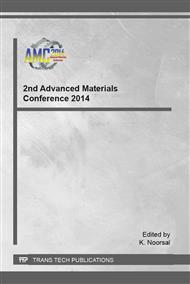[1]
T.D. Sreeja, S.K.N. Kutty, Cure characteristics and mechanical properties of natural rubber/reclaimed rubber blends, Polym. -Plast. Technol. Eng. 39(3) (2000) 501-512.
DOI: 10.1081/ppt-100100043
Google Scholar
[2]
J. Clarke, B. Clarke, P.K. Freakley, I. Sutherland, Compatibility effect of carbon black on morphology of NR-NBR blends, Plast. Rub. Comp. 30(1) (2001) 39-44.
DOI: 10.1179/146580101101541426
Google Scholar
[3]
M.T. Ramesan, The effect of filler content on cure and mechanical properties of dichlorocarbene modified styrene butadiene rubber/carbon black composites, J. Polym. Res. 11 (2004) 333-340.
DOI: 10.1007/s10965-005-6571-y
Google Scholar
[4]
A.T. Petroula, Reinforced elastomers: interphase modification and compatibilization in rubber-based nanocomposites, in: P.M. Visakh, S. Thomas, A.K. Chandra, A.P. Mathew (Eds. ), Advances in Elastomers II: Composites and Nanocomposites, Springer Science & Business Media, Heidelberg, 2013, pp.109-154.
DOI: 10.1007/978-3-642-20928-4_4
Google Scholar
[5]
P. Sae-Oui, C. Sirisinha, U. Thepsuwan, K. Hatthapanit, Roles of silane coupling agents on properties of silica-filled polychloroprene, Euro. Polym. J. 42 (2006) 479-486.
DOI: 10.1016/j.eurpolymj.2005.09.003
Google Scholar
[6]
S.J. Park, K.S. Cho, Filler-elastomer interactions: influence of silane coupling agent on crosslink density and thermal stability of silica/rubber composites, J. Colloid. Interf. Sci. 267 (2003) 86-91.
DOI: 10.1016/s0021-9797(03)00132-2
Google Scholar
[7]
S.Z. Salleh, H. Ismail, Z. Ahmad, Study on the effect of virgin and recycled chloroprene rubber (vCR and rCR) on the properties of natural rubber/chloroprene rubber (NR/CR) blends, J. Polym. Eng. 33 (2013) 803-811.
DOI: 10.1515/polyeng-2013-0127
Google Scholar
[8]
H. Ismail, R. Nordin, The effect of filler loading on curing and mechanical properties of natural rubber/recycled rubber powder blends, Inter. J. Polym. Mater. 54 (2005) 9-20.
DOI: 10.1080/00914030390224256
Google Scholar
[9]
N.R. Kumar, B.R. Gupta, A.K. Bhowmick, Rheological behavior of acrylic and epoxidised natural rubbers, J. Polym. Eng. 13 (1994) 105-124.
DOI: 10.1515/polyeng.1994.13.2.105
Google Scholar
[10]
S. Bandyopadhyay, P.P. De, D.K. Tripathy, S.K. De, Dynamic mechanical spectroscopic studies on the miscibility of polychloroprene-epoxidized natural rubber blend in presence of carbon black, Polym. 36 (10) (1995) 979-(1984).
DOI: 10.1016/0032-3861(95)91441-9
Google Scholar
[11]
N. Rattanasom, T. Saowapark, C. Deeprasertkul, Reinforcement of natural rubber with silica/carbon black hybrid filler, Polym. Test. 26 (2007) 369-377.
DOI: 10.1016/j.polymertesting.2006.12.003
Google Scholar
[12]
P. Sae-Oui, U. Thepsuwan, K. Hatthapanit, Dependence of mechanical and aging properties of chloroprene rubber on silica and ethylene thiourea loadings, Euro. Polym. J. 43 (2007)185-193.
DOI: 10.1016/j.eurpolymj.2006.10.015
Google Scholar
[13]
J. Frohlich, W. Niedermeier, H. -D. Luginsland, The effect of filler-filler and filler-elastomer interaction on rubber reinforcement, Compos. Part A-Appl. S. 36 (2005) 449-460.
DOI: 10.1016/j.compositesa.2004.10.004
Google Scholar
[14]
P. Sae-Oui, C. Sirisinha, C. Wantana, K. Hatthapanit, Influence of silica loading on the mechanical properties and resistance to oil and thermal aging of CR/NR blends, J. App. Polym. Sci. 104 (2007) 3478-3483.
DOI: 10.1002/app.26139
Google Scholar
[15]
N.Z. Noriman, H. Ismail, Properties of styrene butadiene rubber (SBR)/recycled acrylonitrile butadiene rubber (NBRr) blends: the effects of carbon black/silica (CB/Sil) hybrid filler and silane coupling agent, Si69, J. App. Polym. Sci. 124 (2012).
DOI: 10.1002/app.34961
Google Scholar
[16]
I.S. Saad, M. Sh. Fayed, E.M. Abdel-Bary, Effects of carbon black content on cure characteristics, Mechanical properties and swelling behavior of 80/20 NBR/CIIR blend, 13th International Conference on Aerospace Sciences and Aviation Technology, Paper: ASAT-13-CA-06. (2009).
DOI: 10.21608/asat.2009.23488
Google Scholar
[17]
A.R. Azura, S. Ghazali, M. Mariatti, Effects of filler loading and aging time on the mechanical and electrical conductivity properties of carbon black filled natural rubber, J. App. Polym. Sci. 110 (2008) 747-752.
DOI: 10.1002/app.28517
Google Scholar


